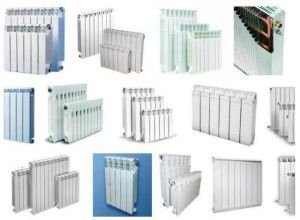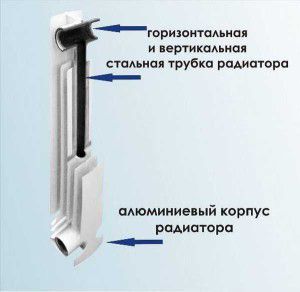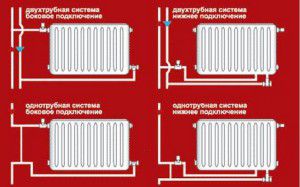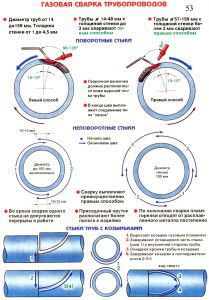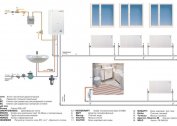The installation of new components in the heating system is always fraught with a number of difficulties. This is especially true for the replacement of batteries, radiators and heating pipes in the apartment. In addition to choosing the best models, you must properly obtain permission to perform this work.
Registration of permission to replace radiators and pipes
For a centralized system, replacing heating batteries in an apartment on their own is not allowed. This is due to the fact that all the elements of central heating are in common ownership (Decree of the Government of the Russian Federation No. 491 p. 6). Installation or modernization of the system may only be carried out with the permission of the Management Company.
The exception is the replacement of heating batteries in the apartment in the winter in autonomous systems that are not connected with common houses. To complete all the documentation you must perform the following steps:
- A statement to the Criminal Code of the intention to install new radiators.
- Obtaining Technical Specifications. It describes the requirements for batteries - heat transfer, heat transfer capacity.
- Selection of batteries according to the obtained parameters. Do-it-yourself replacement of the heating radiator is carried out only under strict compliance with the conditions of the Criminal Code.
- Choosing a radiator installation contractor or do-it-yourself installation.
Is it possible to replace heating batteries in the heating season? A prerequisite is to maintain the desired temperature level in other apartments of the house. At a pre-agreed time, representatives of the Housing Office or the Criminal Code will turn off the heating riser to which the radiator will be connected. After installation, they will inspect the equipment and turn on the heating in this circuit again.
Replacement of heating batteries by gas welding or in another way can be done only after obtaining the consent of the residents of the house whose apartments are connected to this riser.
Choosing heating radiators to replace
After a detailed familiarization with the Technical Conditions (TU), you can proceed to the selection of models of radiators and batteries. Currently, there are many types of components for heat supply on the market and it is difficult to navigate this variety right away.
Can the heating pipes in the apartment be replaced with new ones from another material? Yes, if its technical operational parameters correspond to TU. There is a list of the main characteristics that you need to pay attention to first of all:
- Heat dissipation or rated power. They may be larger or smaller than older batteries. It is important that the capacity is approximately the same. This will affect the cooling of the coolant and, as a consequence, the temperature distribution throughout the house;
- Maximum temperature and pressure. The first parameter is not particularly important. However, the replacement of heating radiators in the apartment by gas welding should be performed only for those models for which the maximum allowable pressure equals the same indicator for the central system. Usually it does not exceed 6 bar. But you need to consider the possibility of water hammer;
- Connection method.
An important point is the battery material and construction. They will largely determine the above characteristics and affect the difficulty of replacing heating batteries in the apartment.
Traditionally, cast-iron radiators were installed in apartment buildings. They are characterized by durability, reliability. However, the high inertness of the heating and mass are their minuses. Therefore, in order to replace heating batteries in an apartment in winter, other types of heating devices are chosen:
- Bimetal radiators. They differ from aluminum in the presence of steel or copper pipelines through which the coolant flows. Manufacturers in this way increased the maximum possible pressure. The vast majority of bimetallic radiators are sectional, which allows you to choose the rated power.
- Panel metal. Relate to the budget option. They are non-separable. They are characterized by the simplicity of replacing heating batteries in the heating season, since the radiator has a relatively small mass.
Aluminum batteries do not have the proper technical qualities for installation in a centralized heating system. Therefore, their installation is not recommended. In addition, the replacement of heating radiators by gas welding will be difficult due to different materials for the manufacture of pipes and batteries.
You can assemble a bimetallic radiator yourself, but only if you have a special key. It can be rented.
Radiator and Battery Replacement Technology
Timely replacement of heating pipes in an apartment building will help prevent emergencies. The same applies to radiators. If there is no experience in performing this work, it is recommended to contact professionals. But in any case, it is necessary, at least in theory, to know the technology for replacing heating batteries with gas welding. You can not change the location of radiators or increase their number without coordination with the Criminal Code. This can lead to an imbalance in the heating system of the house. The day and time of disconnecting the riser is preliminary agreed upon to replace the radiator with your own hands. Then you must perform the following steps:
- Using shut-off valves (faucet), disconnect the radiator from the system;
- Cut the radiator inlet pipe or dismantle the unit if it is threaded. In this case, a hot or warm coolant will necessarily flow - you need to be prepared for this;
- If necessary, new cranes are installed;
- When replacing heating radiators in an apartment by gas welding, an influx of fresh air into the room is necessarily ensured. To do this, you can open the window;
- After dismantling the old battery, fasteners are installed on the wall for the new one. Their location is checked by the construction level;
- The installation of a new battery is carried out only after its final attachment to the wall. The level is pre-checked - when replacing heating radiators by gas welding, the tilt of the radiator is not allowed. This can cause air congestion.
For a one-pipe system, a bypass is surely made that connects the input and output pipes of the radiators. The package should include shut-off valves, a temperature regulator and a Mayevsky tap.
After the final replacement of the heat supply battery, an crimping is done in the apartment. To do this, you will need a special pump, which will pump up pressure to exceed the maximum 1.25 times. This is necessary to identify possible defects.
When replacing heat supply batteries in an apartment in the winter, it is recommended to close the door to the room and put a temporary insulation layer to keep heat in other rooms.
Installing new pipes and radiators using gas welding
To replace steel pipes, it is best to use welding machines. Threaded connections are less reliable and may not withstand the pressure surges typical of central heating.
Replacing heat supply batteries during the heating season is of high quality connection. The technology consists in heating the workpieces to the melting temperature and diffusion of the metal in the weld.
For self-firing replacement of heat supply batteries by gas welding, you will need to perform the following steps:
- Preparatory stage. The place of the future weld is protected, the oxide layer, paint and grease layer are removed.
- The parts are connected and with the help of the burner gases melting occurs in a certain area.
- A special wire is used as solder. Without it, replacement of heat supply batteries by gas welding is impossible. When melted, it fills the joints and forms a high-quality weld. The type of wire depends on the material of the pipe.
- After the formation of the seam when replacing heating pipes in the apartment, the scale is removed and the tightness is checked.
If necessary, an additional layer of welding seam is applied. But experts do not recommend doing this. Excessive temperature effects on pipes when replacing a heating battery with your own hands can affect the characteristics of the metal - it will become more fragile.
Replacing heat radiators with gas welding and forming a seam can be done in different positions - horizontal or vertical. It all depends on the brand of wire.
Installation of polypropylene heating mains
Is it possible to replace the heating pipes in an apartment building with plastic ones? For this, it is necessary to select the correct model of highways according to the parameters of hot water temperature and pressure.
The technology of replacing heating pipes in the apartment with polymer pipes is simpler than installing radiators using gas welding. To perform this work, metal-plastic adapters and a welding machine for polypropylene pipes and special scissors for cutting them will be needed.
An adapter is mounted on the pipe segment, then a trunk is installed. Since under the influence of hot water plastic deformation is possible - fastening is done every 10-15 cm.
As you can see, self-fired replacement of pipes and central heating radiators will require special tools and skills to work with them. This will directly affect the quality of the connection and the further maintenance-free operation of the heating. Therefore, if you wish to do it yourself, it is recommended that you make several test connections using gas welding.
The phased installation of radiators using gas welding is presented in the video material.

